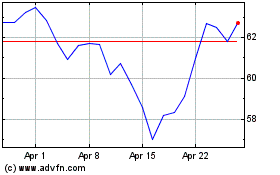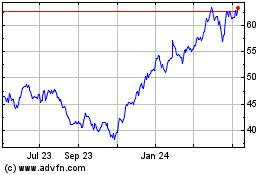Return of brisk buying and selling on Wall Street provided an
infusion for lenders
By Liz Hoffman and Christina Rexrode
The historic U.S. election jolted Wall Street trading desks,
buoying investor confidence and sparking activity that pushed the
five biggest U.S. investment banks to sharply higher fourth-quarter
profits.
The performance marks what could be a turning point for banks
after a fallow period that had some worried the trading business --
the lifeblood of Wall Street and its billion-dollar bonus pools --
was dying for good.
Goldman Sachs Group Inc. and Citigroup Inc. reported quarterly
earnings Wednesday that beat analyst expectations and grew from a
year ago, thanks to a resurgence in long-challenged trading
businesses.
Citigroup's $3.7 billion trading haul was its best
fourth-quarter showing since the financial crisis. J.P. Morgan
Chase & Co., which reported its results last week, had its best
fourth-quarter for trading ever.
"There was increased optimism around the world," said Harvey
Schwartz, chief financial officer at Goldman, where trading
revenues jumped 25% over last year. Noting rising interest rates
and confidence that President-Elect Donald Trump's policies will
spur the economy, he said: "Those are the kinds of things that
always drive our business."
Overall, the five largest Wall Street firms -- Goldman, J.P.
Morgan, Citigroup, Bank of America Corp. and Morgan Stanley -- had
$18.1 billion in trading revenue during the quarter, up 26% from
2015. Those combined results are the highest in any fourth quarter
since the financial crisis.
Banks tend to do better when their clients, such as asset
managers and corporations, are putting money to work, which often
reflects confidence in the economy. In turn, higher bank profits
can make them more confident about lending, spurring further
economic growth.
The hum on bank trading desks also reflects a bout of volatility
after years of calm. Investors shifted billions of dollars from
technology stocks to financial stocks in the wake of the election,
routing more trades through Wall Street's equities trading
desks.
Meanwhile, Mr. Trump's election -- and his steady stream of
comments on everything from outsourcing of U.S. jobs to the
strength of the dollar -- has spurred frantic buying and selling in
global debt, currencies and commodities.
The strong 2016 finish was a welcome respite for trading desks
that started the year in a deep slump. The first quarter is
typically the strongest for trading desks as clients set their
priorities for the year and a fresh wave of corporate securities
flood the market. But in 2016, first-quarter trading revenue fell
about 20%.
Sluggish trading, though, had been a problem for banks for the
better part of this decade. Since the financial crisis, Goldman,
Morgan Stanley and other firms have struggled with tougher rules,
which made trading less profitable, and investor apathy, which
proved hard to shake as interest rates ground lower and economies
across the globe struggled to lift off.
In the following three quarters, however, an acceleration of the
U.S. economy, combined with hopes that the surprise election of Mr.
Trump could usher in lower taxes and other pro-growth policies in
2017, gave Wall Street a string of strong trading results.
The bounce was particularly strong in fixed-income products,
which include corporate and government debt, currencies and
commodities. The performance helped shake the belief that the
business was in secular decline. J.P. Morgan CEO James Dimon last
month estimated that half of the fixed-income trading fees lost
since the crisis would eventually return.
More recently, UBS Group AG analysts estimated that the biggest
banks could post an additional $15 billion in fixed-income trading
revenue over the next two years, with the lion's share accruing to
firms like Goldman, whose hedge-fund clients tend to be
particularly active when markets turn choppier.
Bank stockholders have embraced the surge. The KBW Nasdaq index,
a collection of large bank stocks, is up around 20% since the
election on hopes of lower taxes, lighter regulation and
enforcement, and more-stimulative economic policies.
"The bar has clearly moved higher," said Devin Ryan of JMP
Securities. "The question is whether we will see the real policy
changes" to justify the new valuations.
No firm has benefited more than Goldman, whose shares are up
nearly 30% since the election and have flirted in recent weeks with
highs not seen since 2007.
Goldman on Wednesday reported that earnings rose to $2.35
billion, driven by a 70% surge in bond-trading, which broke $2
billion in revenue for the first time since 2014. Goldman is more
dependent on trading than many rivals and has clung more tightly to
the business, even in the wake of punitive capital charges and
enhanced regulatory oversight. Goldman's shares Wednesday fell
0.6%.
At Citigroup, fourth-quarter trading zoomed up 31%, far better
than the 20% range that the bank guided to early last month. The
gains were shared across both fixed-income, Citigroup's traditional
stronghold, and the smaller stock-trading unit it has been trying
to expand. The bank reported a quarterly profit of $3.57 billion.
Citigroup's stock Wednesday dropped 1.7%.
--Telis Demos contributed to this article
Write to Liz Hoffman at liz.hoffman@wsj.com and Christina
Rexrode at christina.rexrode@wsj.com
(END) Dow Jones Newswires
January 19, 2017 02:47 ET (07:47 GMT)
Copyright (c) 2017 Dow Jones & Company, Inc.
Citigroup (NYSE:C)
Historical Stock Chart
From Aug 2024 to Sep 2024

Citigroup (NYSE:C)
Historical Stock Chart
From Sep 2023 to Sep 2024
